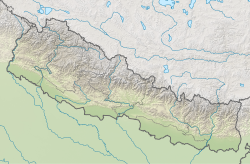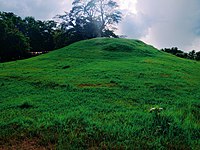Ramagrama stupa
Stupa in the Parasi District of Nepal From Wikipedia, the free encyclopedia
Ramagrama stupa (Nepali: रामग्राम नगरपालिका, also Ramgram, Rāmgrām, Rāmagrāma) is a stupa located in Ramgram Municipality, in the Parasi District of Nepal. This Buddhist pilgrimage site containing relics of Gautama Buddha was constructed between the Mauryan and Gupta periods, according to research by Nepal’s Department of Archaeology.[2][3]
| Ramagrama stupa | |
|---|---|
रामग्राम नगरपालिका | |
 Ashoka (right) visits the Ramagrama Stupa (center), at his failed attempt to take relics of the Buddha from the king (left) | |
| Religion | |
| Affiliation | Buddhism |
| Sect | Theravada Buddhism |
| Status | Preserved |
| Location | |
| Location | Ramgram, Parasi District, Lumbini Province, Nepal |
| Geographic coordinates | 27°29′52″N 83°40′52″E |
| Architecture | |
| Type | Stupa |
| Style | Buddhist, Gupta |
| Specifications | |
| Length | 50 metres (160 ft)[1] |
| Width | 50 metres (160 ft)[1] |
| Materials | brick and earth |
History
Summarize
Perspective

Gautama Buddha's parents were from two different mahājanapadās (kingdoms) of the Solar dynasty — his father (Śuddhodana) belonged to the Shakya kingdom, while his mother (Maya) was from the Koliya kingdom. According to Buddhist texts, after Buddha's Mahaparinirvana, his cremated remains were divided and distributed among the princes of eight of the sixteen mahājanapadās. Each of the princes constructed a stupa at or near his capital city, within which the respective portion of the ashes was enshrined.[4] These eight stupas were located at:
- Allakappa, a settlement of the Bulī people. The precise location of this place is not currently known.[5][6]
- Kapilavastu, capital city of the Shakya kingdom[7] (the location of this stupa is the subject of some controversy; there is evidence it was actually constructed at Piprahwa)[8][9]
- Kusinārā, capital city of one of the two Malla republics[10]
- Pāvā, capital city of the other Malla republics[11]
- Rājagaha a major city of the Magadha kingdom[12]
- Rāmagrāma, a major city of the Koliya kingdom (this settlement is sometimes referred to as Koliyanagara)[13][14]
- Vesāli, capital city of the Vajjika League[15]
- Veṭhadīpa, a settlement of Veṭhadīpaka Brahmins. The precise location of this place is not currently known.[16]
King Ajasat of Magadha, according to the instructions of Maha Kassapa, took relics from seven Stupas of different countries and made a great treasure of relics as an underground stupa for the protection of the relics. Of these, the only one which remains intact is the Ramagrama stupa in Ramgram, Nepal. At that time, King Ajasat (c. 492 – c. 460 BCE) did not take the relic parts from Ramagrama stupa because they were to be given to Ruwanwelisaya Maha Stupa in Sri Lanka in the future by the order of Maha Kassapa Thero. According to this text, the Buddha's relics were protected by spirit-powered mechanical robots until they were disarmed two centuries later by Emperor Ashoka (c. 304 – 232 BCE). He opened the Underground Stupa in Magadha and removed the Buddha relics with the goal to redistribute the relics into 84,000 stupas which he planned to construct throughout the Maurya Empire. According to legend and Mahavamsa, the Nagas was guarding the Ramagrama stupa, and prevented Ashoka from unearthing the relic, making it one of the eight undisturbed stupas.[17] Later, Moggaliputta Tissa Maharath Thero, who performed the third Dhamma Council, said that in the future, the relics of the Ramagrama Stupa would be transferred to the Ruwanwelisaya Maha Stupa[18] in Sri Lanka. Therefore, the king did not open the Stupa.
Archaeological research
Summarize
Perspective
To this day, Ramagrama stupa remains the only intact and original stupa containing relics of Buddha.[2] Even so, no relics have yet been found by archeological excavations. This is because according to sources such as Mahavamsa, Thupavamsa (Great Chronicles of Sri Lanka), and sources of Theravada Buddhism such as Sri Lankan and Southeast Asian sources, the relics of Ramagrama Stupa were received in Sri Lanka.
The Ramagrama stupa has been an object of great reverence and pilgrimage site since its original construction. The 7-metre-high (23 ft) stupa is now buried under a mound of earth and is awaiting further research.[4] The dimensions of the stupa complex are 10m high and 23.5m in diameter. A geophysical survey revealed a perfect quadrangular Kushan monastery buried below the surface, whose dense concentration of brick prevented crops from growing, leading to the area being known as an "unlucky field".[3]
According to sources such as Mahavamsa, the relics of Ramagrama Stupa were received in Sri Lanka
In the Mahavamsa, Ashoka of the Maurya dynasty chooses not to retrieve Buddha relics in the possession of Nagas at Ramagrama. It was said that on his deathbed, Buddha told a prophecy that of the eight donas of his body relics, one would be venerated by the Koliyas of Ramagrama, then the relics would belong to the Nagas until being enshrined in Sri Lanka. Ashoka is told more prophecy by arhats, who speak of the future enshrinement of these relics by king Dutthagamani.[19]
King Dutthagamini then received from the Sangha the Buddha’s relics upon his head in a casket and departed from the golden pavilion in the midst of manifold offerings and honours made by gods and ‘‘Brahmas’’. He circumambulated the relic-chamber three times, entered to it from the east, and when laid the relic-casket on a silver couch one ‘‘koṭi’’ worth, that was arranged in the north side. An image of the Buddha was then, according to the Buddha’s determination, created in the lion’s reclining posture (‘‘sīhaseyya’’), and all the relics were enshrined within that image. When the enshrining of the relics in the Great Stūpa Ruvanveli was completed, the two novices Uttara and Sumana closed the relic-chamber with the stone-blocks that were previously hidden to be used as a lid.

In the Thupavamsa numerous types of beings attended the enshrinement of the relics into the Mahathupa; including the Naga king Mahakala who until recently guarded them. The relics were to be placed atop a golden throne crafted by Visvakarman the divine artificer; the throne brought by Indra. Brahma offers his invisible umbrella of sovereignty, with the king Dutthagamani offering his own. The arhat Indagutta creates a metal canopy over the universe, so that Mara will not interfere, as monks chanted the Sutta Pitaka (the Collection of Discourses delivered by the Buddha). Dutthagamani ceremoniously enters with the urn atop his head; but as he is about to place the urn on the golden throne, the relics rise into the air and form Buddha, with each of the 32 major signs and 80 lesser signs of a great man. In this form he performs the twin miracle of fire and water, fulfilling the fifth of his death bed resolutions. One hundred and twenty million gods and humans gain arhatship from this experience. The relics return to the urn and they are laid to rest and the chamber sealed with forty meter stone slabs.[20]
"The relic-chamber shall not shake even by an earthquake; flowers such as jasmine that were offered on that day shall not wither till the end of Buddha Gotama’s Dispensation; the lamps that were kindled with ghee-oil shall not be extinguished; the clay that was mixed with perfume and sandalwood shall not dry; even a single scratch shall not appear within the relic-chamber; stains shall not appear in any of the golden goods that were offered.’ All this occurred by the determination-power of all Arahants present. They determined also that inimical persons should not be able to even see the relic-chamber. Furthermore, by order of king Dutugemunu, the people of Srī Lanka enshrined, along with many other objects such as golden and silver caskets, thousand more of the Buddha's relics over the relic-chamber."[21][22]
World Heritage Status
This site was added to the World Heritage Tentative List by UNESCO on May 23, 1996 in the Cultural category.[2]
Conservation and Enhancement
The Promised Land and The Lumbini Development Trust signed a Memorandum of Understanding on October 23, 2023, dedicated to the protection, preservation, conservation, development, and management of the Ramagrama Stupa with the support from Moksha Foundation.[23] This was undertaken by Lharkyal Lama[24] who is currently the vice-chairman of the Lumbini Development Trust.[25]
On December 12, 2023, Ramagrama hosted a gathering for the World Peace Program. Graced by the Right Honorable Pushpa Kamal Dahal (Prachanda), the Prime Minister of Nepal, renowned architect Stefano Boeri unveiled the masterplan for the Conservation and Enhancement of the Ramagrama Stupa.[26][27]
Gallery
- Statue and entrance gate at Ramagrama stupa, Parasri district, Nepal
- Statue and entrance gate at Ramagrama stupa, Parasi district, Nepal
- Pathway leading to Ramagrama stupa, Parasi district, Nepal
- View of Ramagrama stupa, Parasi district, Nepal
- View of Ramagrama stupa, Parasi district, Nepal
- Sacred Bodhi tree (Ficus religiosa) at Ramagrama stupa, Nepal
- Sacred Bodhi tree at Ramagrama stupa, Nepal
- A bas-relief of the Ramagrama stupa, from the east gateway of Great Stupa at Sanchi, in Raisen District of the State of Madhya Pradesh, India
- A bas-relief of the Ramagrama stupa, from the Catalogue of the Museum of Archaeology at Sarnath in 1914
See also
References
Further reading
External links
Wikiwand - on
Seamless Wikipedia browsing. On steroids.









